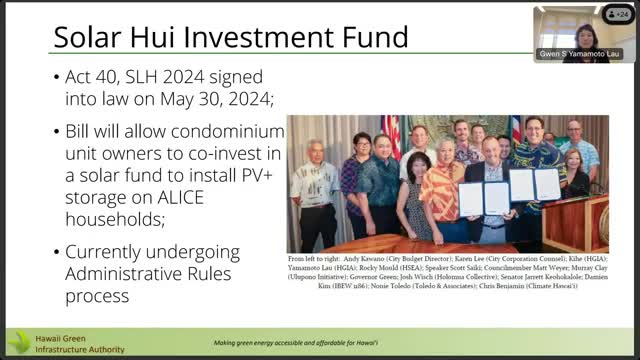Hawaii Launches Solar Co-Investment Fund for Condominium Owners and ALICE Households
July 19, 2025 | Public Utilities Commission (PUC), Executive , Hawaii
Thanks to Scribe from Workplace AI , all articles about Hawaii are free for you to enjoy throughout 2025!

This article was created by AI using a video recording of the meeting. It summarizes the key points discussed, but for full details and context, please refer to the video of the full meeting. Link to Full Meeting
The conference began with a discussion on a new bill that allows condominium unit owners, who do not own their rooftops, to co-invest in a fund for the installation of photovoltaic (PV) systems and storage solutions for ALICE (Asset Limited, Income Constrained, Employed) households. This initiative aims to reduce energy costs for these households while providing tax benefits to condominium owners.
Next, the Hawaii CPACER financing program was launched on July 1, 2024, featuring 14 capital providers. This program does not depend on state funding and supports a range of qualifying improvements, including clean water, energy efficiency, and renewable energy projects.
The HGIA also reported on its partnership with the Hawaii Technology Development Corporation, which administers three credit-related programs under the state small business credit initiative. This federally funded program has successfully unlocked over $30 million in capital for various industries, including hospitality, healthcare, and energy.
A key focus of the meeting was the urgency of implementing the governor's vision to facilitate the addition of at least 50,000 new distributed renewable energy installations for low and moderate-income households. The recent signing of the 1 Big Beautiful Act has intensified the need for action, as the 30% federal solar tax credit is set to expire soon.
The Solar for All program was highlighted as a comprehensive initiative that not only provides financing but also includes technical assistance and workforce development. However, strict eligibility requirements pose challenges for potential applicants, particularly for multifamily projects that must meet specific income limitations.
The HGIA announced that it has approximately $22 million in solar plus storage loans available. Despite changes in federal tax credits, the authority emphasized that its financing model relies on energy savings rather than tax incentives, making it a viable option for underserved communities.
In closing, the HGIA requested the commission to consider reversing order 34940 to release $18 million in GEMS loan capital for immediate use by nonprofits and small businesses. This move is seen as crucial for supporting the installation of renewable energy systems and ensuring that underserved ratepayers can benefit from these initiatives.
The meeting underscored the collaborative efforts and strategic planning necessary to advance Hawaii's clean energy goals while addressing the needs of its most vulnerable populations.
Converted from GEMS Status Conference with Hawaii Green Infrastructure Authority (HGIA) - Docket No. 2014-0135 meeting on July 19, 2025
Link to Full Meeting
Comments
View full meeting
This article is based on a recent meeting—watch the full video and explore the complete transcript for deeper insights into the discussion.
View full meeting
